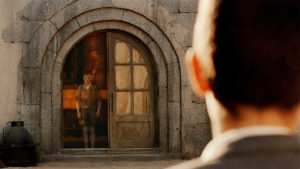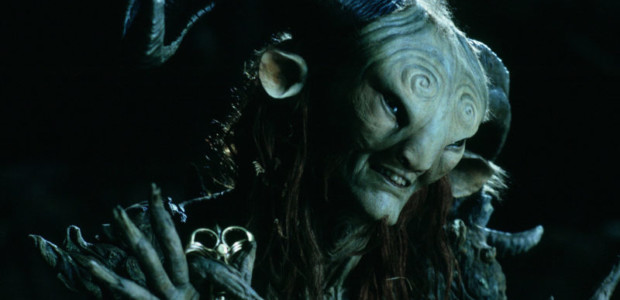In the early 2000s, Guillermo Del Toro released a pair of sister films about the Spanish Civil War. He began with THE DEVIL’S BACKBONE in 2001 followed by PAN’S LABYRINTH in 2006. Both of these films have a rich backstory as they deal with different periods of the Spanish Civil War. Each film tells a story about the state of Spain through its settings.
THE DEVIL’S BACKBONE (2001)

Guillermo Del Toro previously mentioned he considers THE DEVIL’S BACKBONE his first official film. And how could he not? This film is filled with so much lore and fantastical elements that Del Toro became famous for. He uses catastrophes from the Spanish Civil War as a catalyst for his ghost and settings.
As the Spanish Civil War nears the end in 1939, 12-year-old Carlos (Fernando Tielve) arrives at an all-boys orphanage. His father is killed and Carlos is to spend the rest of his youth inside the decrepit establishment.
As the days go on Carlos begins to unravel the mystery of a child who died right before his arrival. Within the first few minutes of the film, Guillermo Del Toro already correlates death with the war. We have the child narrator asking what a ghost is, Santi’s (Junio Valverde) death, and the mention of Carlos’s dead father. Death is inevitable.
With older films like Luis Buñuel’s LOS OLVIDADOS (THE YOUNG AND THE DAMNED) and Héctor Babenco’s PIXOTE and more modern examples like Issa López’s Vuelvan (TIGERS ARE NOT AFRAID), forgotten children is a theme that runs through Latin American and Spanish films.
Del Toro uses this theme with the children of his film. The orphanage is a perfect metaphor for kids who are left behind and forgotten, especially caused by war. In THE DEVIL’S BACKBONE, the orphanage is a forgotten establishment for forgotten children. Its low funding is obvious by the rusting exterior that resembles dripping blood. Guillermo Del Toro also follows the all-girls boarding school setup and inverses it.
Carmen (Marisa Paredes), the authoritative figure, is typically seen as a tyrannical leader like in Narcisco Ibáñez Serrador’s LA RESIDENCIA (THE HOUSE THAT SCREAMED). In this case, Carmen is the only one actively caring for the children alongside Dr. Casares (Federico Luppi).
Keep in mind the film takes place when Spain is close to gaining a dictator as Francisco Franco comes into power. Eventually, Franco turns Spain into a fascist regime supported by the church. Oppression isn’t directly staring into the children’s eyes but it is in the air. Aside from the forgotten children, Guillermo Del Toro uses the setting outside of the orphanage to comment on the state of Spain during these violent times. The outside is a forgotten bare landscape. The bleakness steams up from the hot sand. It’s the perfect representation of the uncertain future of the Spaniards.
The unknown lies outside of the orphanage while the children live in an open feeding ground for the Nationalists. The dud bomb in the center is a constant reminder. Towards the end of the film, the orphanage explodes. Their home is now in a fiery blaze. The remaining survivors are set free from the clutches of the forgotten orphanage. But first, the children must unite and fight against the real threat; man’s aggression. After their successful and vengeful fight, the children walk into this barren landscape of uncertainty. Although their home is turning into ashes and they walk into the desert, their new home is among themselves and the memories of the forgotten.
PAN’S LABYRINTH (2006)

Post-Civil War Spain in 1944 is a bloody time with the guerillas fighting to overcome the fascist regime. Captain Vidal (Sergi Lopez) is as cruel as any fascist leader can be. The bottle scene in the beginning of PAN’S LABYRINTH depicts the cruelty of war and Vidal’s ruthless reign by savagely killing a hunter and his son. No remorse and full of intimidation.
Although bleakness runs through PAN’S LABYRINTH there’s something else running in the background; hope for a better Spain. Even though Franco has officially taken over the country, there’s a glimmer of aspiration within the rebels. They are outnumbered and outgunned but they continue to fight on.
Guillermo Del Toro uses the setting of the forest to speak about the rebel’s hope. The green scenery can be seen as starting anew. But the horrors are still prominent regardless of Spain’s turmoil(s) and its changing political stance. Just because there’s a chance to start something new doesn’t mean it’ll come easy. Anything worth fighting for comes with a price.
Amid this horror fantasy epic, Ofelia and her brother are other forms of hope for the rebels. This is represented by flowers in nature. We first see this when Ofelia is laying down next to her pregnant mother. She begins to tell a story to her unborn brother about a magical rose on top of a mountain. But instead of focusing on the beauty of the blossoming rose, Ofelia focuses on the darkness and destruction surrounding it. How no man dared to go near it because of the poisonous thorns.
This story represents the evil surrounding Ofelia and her brother. They are untouched forms of good. With all the destruction of the Spanish Civil War and fighting between the rebels and the Nationalists, children are the sign of a better Spain. If we compare this to THE DEVIL’S BACKBONE, the children aren’t represented as hope because of the uncertainty of Spain’s politics. Children are stuck between the crossfire of two forces with the bleakness emerging from both sides.
Femininity is another theme that runs alongside hope. These two themes clash during Ofelia’s first task. To regain her title as Princess Moana, she must retrieve a key from a frog living under a fig tree. Unlike the rose in the imaginary story, this tree is withering. Its branches are drying up as it slowly decays. Death is near.
If you take a good look at the tree it resembles a withering uterus. As masculinity thrives in the environment of war, the femininity of the motherland loses. Women are left behind to suffer just like the children. Unknowingly to Ofelia, defeating this task is a step closer to bringing hope and a flourishing life to femininity and her family tree.
During the resolution of the film, Ofelia sacrifices her life to save her brother as well as opening the portal to her princess lineage. Before Vidal’s death, he is told his son will never know his biological father. This film doesn’t end on a bleak note of uncertainty. Instead, the final shot is of a white flower blossoming on Ofelia’s once decaying family tree from the first task. Although Franco is still in power, hope lives on for a better Spain.


No Comments